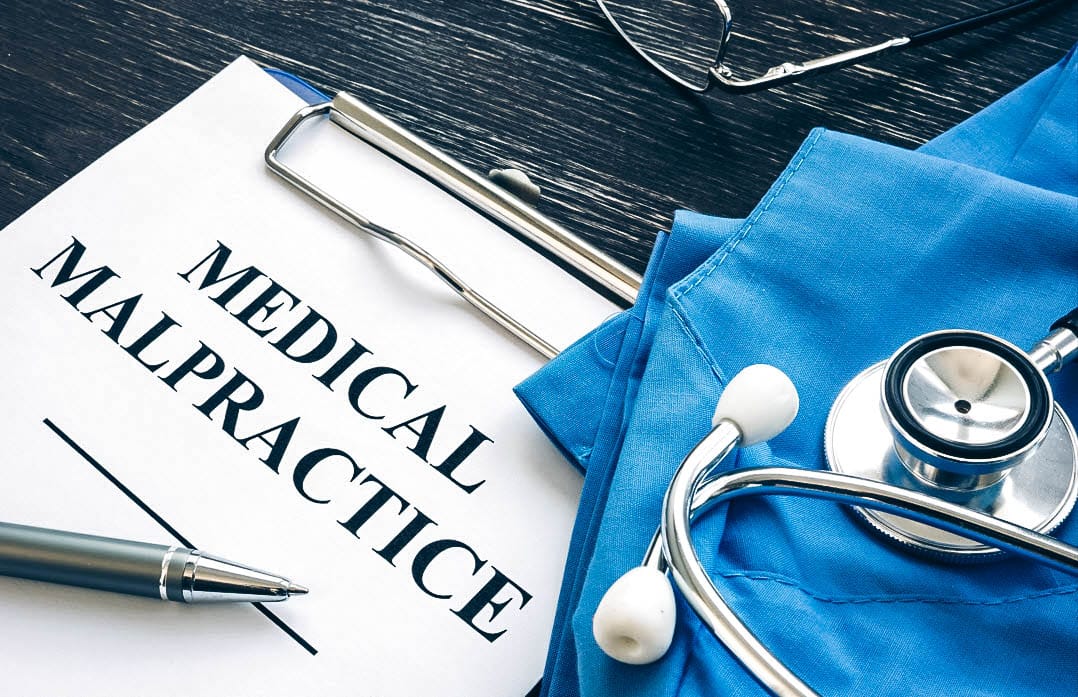How Do I Know if I Have a Medical Malpractice Case?

Wondering, “How do I know if I have a medical malpractice case?” If a healthcare provider acted negligently and injured you or killed a loved one, you could have grounds for a medical malpractice case. To have a successful case, you must prove that a doctor-patient relationship was in place, the medical professional was negligent, the negligence caused an injury, and the injury resulted in damages. Medication errors, failure to diagnose, and surgical errors are common forms of negligence leading to medical malpractice claims. Not every undesired or bad result means that a doctor or nurse committed medical malpractice. The best way to know if you have a medical malpractice case is to speak with an experienced attorney.

Table of Contents
How Do I Know if I Have a Medical Malpractice Case?
When you visit a doctor, clinic, or hospital, you expect to be cared for properly and get the necessary medical assistance and healing. Unfortunately, healthcare providers sometimes commit medical malpractice, injuring many patients and killing more than 250,000 Americans every year.
If you suspect that you’ve suffered harm at the hands of a doctor, it’s important for you to seek medical help and talk to a medical malpractice attorney. Likewise, understanding the basics of a medical malpractice claim and the common types of mistakes made that lead to those claims is helpful. Additionally, there are warning signs that you can look for to help you determine if you have a valid case.
What Are the Basic Requirements of a Medical Malpractice Case?
Not every bad result or complication is caused by medical malpractice. Some injuries occur even if medical professionals provide good care and follow all the standard procedures. Such injuries are the recognized or accepted risks of procedures and treatment. Other injuries and conditions are unacceptable, the result of a medical mistake.
To prove medical malpractice, four elements must be present:
The Doctor Owed You a Duty of Care
Proving this element entails showing that a professional relationship existed between you and the physician, nurse, hospital, or some other party that rendered medical care. The relationship obligates the medical professional to provide you with a particular standard of care.
Generally, you can satisfy this element by showing that you were under the care of a healthcare provider for a procedure or appointment. For example, a physician-patient relationship exists if a doctor starts seeing you and providing treatment. On the contrary, a relationship doesn’t exist if you overhear a doctor giving advice at a party, and following the advice causes harm.
The Doctor or Provider Breached the Duty of Care
To sue for medical malpractice, you must prove that the doctor or nurse’s conduct fell below the standard of care. You can do this by showing that the doctor failed to act with the skill and care that a similarly trained healthcare professional would have exhibited under similar circumstances. The doctor is required to be reasonably skillful and careful.
You may need to present a medical expert in the same field as the doctor you are suing to show the appropriate standard of care and how the doctor in question deviated from it.
The Breach Caused the Injury
Even if a medical professional performed below his or her field’s expected standards, you must show that his or her actions caused your injury. You won’t have a medical malpractice case if there isn’t a relationship between a doctor’s actions and your injury.
This element can be difficult to prove because medical malpractice cases usually involve patients who are already sick or injured. One defense that a doctor may use is he or she did not cause your injuries and that they are related to your original illness or preexisting condition.
Your medical malpractice lawyer may be familiar with such defenses and know how to counter them. For example, your lawyer may use the eggshell skull rule that protects the rights of people with preexisting conditions that make them more vulnerable to injuries. Medical malpractice lawyers also work with medical experts to testify and link a patient’s injuries to the doctor’s negligence.
You Suffered Damages Because of the Injury or Malpractice
Finally, you must show that you actually experienced harm or incurred medical expenses because of the doctor’s action. These are called damages. The damages may include compensation for economic and non-economic harm:
- Medical bills
- Lost income
- Loss of future earning capacity
- Pain and suffering
- Emotional distress
Common Types of Medical Malpractice
Medical malpractice can happen to anyone, at any time, in any way. But some types of malpractice are more common.
You may have a viable claim if you have been a victim of one of these common medical mistakes:
Failure to Diagnose
A 2013 study found diagnostic errors to be the most common error leading to successful medical malpractice claims. Diagnostic errors occur when you are given an incorrect diagnosis or the correct diagnosis is delayed due to factors like the misinterpretation of test results and poor follow-up. According to a 2014 study, it’s estimated that health professionals misdiagnose 12 million Americans each year.
Failing to diagnose a patient correctly can prevent effective treatment and lead to severe consequences. For example, ignoring or misinterpreting test results and failing to make the appropriate diagnosis could delay proper treatment and cause further injury or death. A delayed cancer diagnosis could allow the cancer to metastasize, leaving the patient facing more rigorous treatment, permanent disfigurement, or death.
You can hold a doctor liable for the injuries resulting from a misdiagnosis if a competent doctor would have given you a different diagnosis or discovered your illness, leading to a better outcome than what your doctor achieved.
Medication Errors
Medical professionals must approach every prescription with caution and consider factors like a patient’s prior illness, age, and current condition. When a healthcare professional fails to review your medical history, doesn’t recognize potentially dangerous drug interactions, pays little attention to a prescription order, or is fatigued, he or she may make a medication error. Common medication errors include:
- Prescribing the wrong amount or type of medication
- Prescribing unauthorized drugs
- Dispensing the wrong medicine
- A pharmacist filling the instructions incorrectly
- Prescribing a drug that a patient is allergic to
- Giving a drug that interacts poorly with the patient’s other medicines
Medication errors can cause several adverse effects, such as allergic reactions, disability, and even death.
Surgical Errors
Although surgeries carry many risks, there are protocols and procedures that enhance patient safety and lower the risk of harm significantly. Negligence by the surgical team can lead to avoidable errors. Wrong-site surgery, leaving surgical implements in the body, errors in anesthesiology, improper sterilization of surgical instruments, and inadvertently cutting an organ or blood vessel are common surgical errors.
You can hold the surgeon and the rest of the surgical staff responsible for the additional injuries that surgical errors cause.
Lack of Informed Consent
Before a procedure or treatment, a doctor has the duty to warn you of the known risks. Lack of informed consent happens if you’re injured during a procedure and the doctor didn’t sufficiently tell you about those risks. If you would have made a different decision about the procedure if that doctor had told you about the risks, he or she may be liable for malpractice.
Equipment Failure
You can hold healthcare providers liable if a mechanical failure occurs during treatment and the reason for the failure was due to monitoring or maintenance. Incorrect use of medical equipment can also lead to a medical malpractice claim.
Hospital Malpractice
You can get injured due to the way a hospital operates. The hospital could be held liable in a medical malpractice lawsuit if you receive substandard care because it hired underqualified or incompetent staff or an insufficient number of staff. Likewise, a hospital may be liable if the facilities fall below industry standards or are unsanitary. Further, preventable communication errors and improper protocols can lead to a malpractice claim.
What Are the Common Signs of Having a Medical Malpractice Case?
If the medical error behind your injury is not immediately apparent, you may find it challenging to know whether you may have a medical malpractice case. Here are some red flags to watch out for that could indicate you are a medical malpractice victim.
Worsening of Symptoms
If you are taking unusually long to recover after treatment or your symptoms are worsening with the prescribed treatment, you could have been misdiagnosed or received the wrong treatment. Illnesses usually worsen over time without the correct treatment, so the misdiagnosis or incorrect treatment puts you at more risk of being sicker or sustaining additional injuries.
Developing New Symptoms
Getting new symptoms after medical treatment could be a sign of a mistake having been made in your treatment plan or diagnosis. For instance, unexpected developments after a procedure could be due to an error made during surgery.
Differing Second Opinion
If you seek out a second opinion and it differs significantly from the initial diagnosis, your first doctor could have been negligent and given you a wrong diagnosis.
Insufficient Follow-Up
Doctors or nurses may be committing medical malpractice if they neglect following up after a procedure or keep brushing off your concerns about a symptom or condition.
Treatment Plan Not Suited to the Severity of Your Illness or Injury
You may be a victim of medical malpractice if the treatment you received is expensive and seems excessive or unnecessary in relation to your illness or injury. Seeking a second opinion can help you boost your claim.
Someone Admitted Fault
A member of the medical team apologizing or admitting fault for an error that led to an injury is a clear red flag. You likely have a viable medical malpractice claim.
Understaffed Facility
You may have a medical malpractice case if you receive inadequate medical care in a facility that seems understaffed, particularly if the neglect causes more health problems.
Poor Treatment Leading to Death
If a loved one died following a misdiagnosis, delayed diagnosis, a medication error, or having their needs ignored, your family could sue for medical malpractice.
How Can a Medical Malpractice Attorney Help?
Medical malpractice cases are highly complex, involving both law and medicine. Medical malpractice attorneys have a solid understanding of both areas of expertise and usually, work with qualified medical practitioners. A medical malpractice attorney will carefully evaluate your medical documents and consult competent medical experts to help you know if you truly have a claim.
The basic legal concepts of liability, causation, and damages apply to most medical malpractice cases. An attorney will look for signs of negligence in your case, identify the potentially liable parties, and file a claim against them. The attorney will gather the relevant evidence to support your claim and obtain the experts you need to prevail on your medical malpractice case.
A medical malpractice attorney will also help you calculate your damages from the harm suffered, accounting for both your current and future damages. He or she will negotiate on your behalf and seek the maximum compensation possible.
It’s costly to gather evidence and work with qualified medical practitioners when pursuing medical malpractice claims. However, medical malpractice attorneys have the necessary resources to cover these costs. In Illinois, you only have two years from the date you recognized the medical malpractice injury to bring a claim. Therefore, the sooner you contact a medical malpractice attorney, the more time the attorney will have to help you build a strong case.



